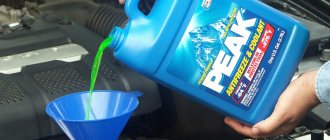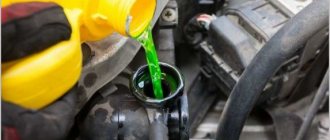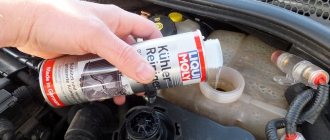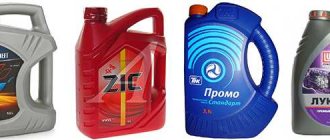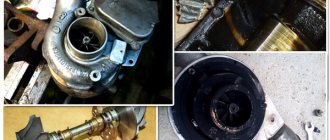What could be the consequences?
Since antifreeze is a concentrate with distilled water, its penetration into the oil causes the lubricant to partially lose its properties. Driving miles on diluted oil provokes rapid wear and the need for major repairs of the internal combustion engine.
Antifreeze getting into the engine
Before determining whether antifreeze is getting into the lubrication system, listen to the engine. If it begins to knock quite quickly on parts of the crankshaft liners, this is the first sign of a malfunction. Other consequences of antifreeze getting into the oil include:
Consequences of antifreeze getting into the cylinder block
It doesn’t matter what kind of liquid gets into the engine, it could be ordinary antifreeze or modern expensive antifreeze, the consequences will be identical. Further operation of the vehicle in the usual sense is not permitted. Coolant (hereinafter referred to as coolant) cannot harm the engine, even taking into account the aggressive and toxic components included in its composition. The problem is that ethylene glycol, which most coolants are made of, when mixed with engine oil, is converted into a solid, insoluble component, similar in action to abrasive materials. All rubbing parts quickly wear out and fail.
White emulsion on the plug: a clear sign of coolant in the oil
The second problem is a kind of scale or emulsion in the form of deposits on the walls of oil lines and numerous channels. The filters cannot cope with their task because they are simply clogged, the oil circulation is disrupted and, as a result, the pressure in the system increases.
The next problem is dilution of the engine oil, as a result of which the washing, lubricating, protective and other properties are lost. All this together invariably leads to overheating of the power unit and deformation of the cylinder block and its head. It doesn’t matter at all whether the engine is gasoline or diesel, the consequences will be similar.
Read more: Hyundai Greta gray color
Engine flushing
It starts with draining the spoiled oil, which contains antifreeze in it. The system is then filled several times with flushing oil. Because You will need a decent amount of it; it is better to take a few liters of the most budget option. After the lubrication system is completely cleared of any antifreeze that has entered it, new oil is poured in. It is advisable to complete the cleaning by installing a good oil filter.
Flushing the engine with a special agent
Remember: motor oil mixed with antifreeze provokes a negative effect on engine performance, especially in the future. If you notice this phenomenon, immediately identify the problem and fix it.
Have you mixed antifreeze with water?
Source
Symptoms of coolant in oil
For the reasons given above, it is most often not possible to notice in time the loss of tightness of the cooling system in the cylinder head/cylinder head area. At the same time, problems leading to mixing of two technical fluids circulating through separate lines can be very serious. An example is the depressurization of CO in the area of the heat exchanger gasket or the already mentioned leak due to a breakdown of the cylinder head gasket. In some cases, we can talk about damage to the oil cooler, which also leads to mixing of antifreeze and MM.
We list the main signs that allow you to determine how antifreeze gets into the engine oil:
- If, during the procedure for replacing antifreeze, you find that a liquid of a noticeably darker color flowed during the draining process, you can assume that this is a lubricating liquid that has a lower density and therefore rises to the upper part of the radiator. Of course, the consistency of the liquid also changes, so much so that it flows out of the drain hole with great difficulty. That is, in a calm state, these technical fluids do not mix. Having different viscosity/density indicators, they behave differently, which is easy to notice if you are observant and unaware of possible trouble;
- Another common way to determine whether antifreeze has gotten into the oil is using matches or a lighter. The fact is that antifreeze in its pure form does not burn (although it contains ethylene glycol, it is diluted with water in a non-flammable consistency). But if motor oil gets into it, such a liquid can already be set on fire. This is what this method is based on. We take an ordinary paper napkin, dip it in antifreeze and try to burn it. If there is oil in the coolant, the piece of paper will certainly burst into flames; if the antifreeze is clean, nothing will happen. Since this method is fire hazardous, when using it, you must comply with all fire safety requirements and carry out this procedure at a fair distance from the car;
- although the oil viscosity is much lower, this does not mean that mixing always occurs one-way when antifreeze enters the MM. Sometimes the opposite situation occurs when oil penetrates the cooling system. In this case, depressurization can also be determined by color: the lubricating fluid should darken. This is especially noticeable if it has been changed relatively recently (old oil darkens for natural reasons - due to contamination);
- One of the simplest and most obvious ways to determine the presence of antifreeze in oil is to monitor fluid levels. If the expansion tank gradually becomes empty, and the level on the oil dipstick, on the contrary, increases, it is not difficult to understand what is happening. Especially if there are no visible signs of antifreeze leakage;
- When coolant enters the cylinders, it mixes with exhaust gases, turning into a gaseous state. The color of the exhaust will change to light (normally it is almost transparent) - this is the result of the presence of water vapor in the exhaust. In winter, this is not an obvious sign of CO depressurization, since moisture enters the exhaust pipe from the air, but in summer such a symptom is difficult to miss;
- a sure sign of mixing technical fluids is the presence of a whitish emulsion that appears in the area of the oil filler neck, with a consistency reminiscent of whipped cream - this is the result of coolant getting into the lubricating fluid;
- You can see if antifreeze gets into the oil by unscrewing the spark plugs. If the electrodes are wet, sniff them. The characteristic smell of antifreeze is a clear indication that coolant is entering the combustion chamber;
- finally, deterioration in the performance of the power unit and the appearance of tripping is another potential symptom of oil contamination with antifreeze. True, not very reliable - many other malfunctions lead to the same result.
One of the main signs is emulsion in oil.
Heat exchanger or how to understand that antifreeze has got into the oil!
Heat exchanger
is a technical device in which heat is exchanged between two media having different temperatures.
Let's just say frankly the weak point of all modern engines!
Mixing motor lubricant with engine coolant is a critical malfunction that requires immediate intervention and elimination. In other words, the car cannot be operated, only repaired. Although infrequent, this problem occurs on new and used cars. To avoid costly repairs, the car owner must clearly understand the procedure for his actions when oil is found in antifreeze.
The cooling system of the power unit is a network of channels passing through the block and cylinder head. It is sealed and therefore operates under pressure resulting from the heating and expansion of the liquid. The lubrication system has a similar structure, only the channels are narrower, and the pressure is created by an oil pump.
It is extremely important to monitor the levels and condition of technical fluids, oil and antifreeze.
There are several reasons why two different liquids mix:
How to determine whether lubricant has gotten into antifreeze:
As a rule, trouble does not come alone. Antifreeze that gets into the oil pan can create serious problems: at best, the emulsion will clog the lubricating channels and filter. In the worst case scenario, the crankshaft will rotate the bearings (sliding bearings) as a result of oil starvation. Expensive repairs are guaranteed.
The sign of a breakdown is clearly visible - white smoke pours out of the exhaust pipe in large quantities, and the engine power drops sharply.
When a similar problem occurs on a machine equipped with a heat exchanger - a motor lubricant cooler, difficulties arise with self-diagnosis of the malfunction. If there are no external signs in the form of drips, then after identifying the emulsion in the expansion tank, immediately contact our auto repair center, we will replace the heat exchanger gaskets and flush the oil and cooling systems.
On GM cars, the heat exchanger is located behind the manifold and is constantly exposed to strong heat, which causes the gaskets to harden and oil to leak!
All modern motors are heat-loaded, the operating temperature of the motors reaches 103-105C, and for some motors it is even higher. Engine detonation, dried plastic tubes, oak rubber gaskets and premature oil oxidation are the price to pay for environmental friendliness.
Car oil in antifreeze
The opposite also happens. When motorists see traces of grease on the walls of the expansion tank, they ask themselves the question: “Why is there oil in the antifreeze?”
The car oil from the lubricating complex somehow ends up in the cooling system, but everything is fine with the oil liquid. Its volume, shade, viscosity do not change.
Experienced drivers in such situations say: “The end of the cylinder block.” Usually these words are true. Through a crack in the block, part of the lubricant enters the cooling complex and curls up there. An emulsion is formed.
It is almost impossible to replace the cylinder block on your own. You must contact a specialized service center.
How to determine if antifreeze has entered the engine
Many drivers have a question about how to know that antifreeze is getting into the engine. This can be understood by the following signs.
Drop in antifreeze level. This does not always indicate a leak in the lubrication system. Instead of the engine, coolant may simply end up in the engine compartment.
Emulsion appears. You can check its presence using a dipstick and looking at the oil filler neck. It looks like a dirty white or yellowish liquid, which consists of antifreeze or antifreeze mixed with oil. This mixture forms at the neck, under the lid. Sometimes scale appears along with it on the walls of channels and oil lines. The more coolant that gets into the engine oil, the more emulsion you will see.
Unstable engine operation and engine overheating. If oil and antifreeze are mixed, the operation of the cooling and lubrication systems will be disrupted. In this case, the engine will overheat very quickly, especially if the car is running at high speeds. This may also be accompanied by a change in the operation of the motor (for example, it will begin to “triple”).
Oil getting into antifreeze. If the tightness of both systems is broken, mutual mixing of the liquids in them occurs. Therefore, you can look into the expansion tank and check: if the antifreeze smells like burnt oil and turns black, this means that it has entered the cooling system.
White smoke. Coolant enters the cylinders of gasoline vehicles and the manifolds of diesel vehicles, so they are sensitive to changes in operation. If light-colored smoke, more like steam, comes out of the exhaust pipe, this indicates antifreeze has entered the engine.
The spark plugs and crankcase become lighter. A whitish coating may be a sign of burnt antifreeze.
Air bubbles. They indicate depressurization of the system and may appear in the expansion tank of the cooling system, especially at high speeds. To see the bubbles, you need to look under the cap or take a closer look at the body of the tank.
Antifreeze leaks. If coolant is leaking from under the cylinder head gasket, this is a serious signal that it has got into the oil and you need to check the engine immediately.
How to find an antifreeze leak
Since coolant can leak from different places in the system, you need to know where and how to look for the problem area.
Visual inspection of pipes and clamps
By visual inspection, you can identify areas of coolant leaks. The more it leaks, the easier it is to find the leak. The procedure should begin with the pipes, since on many cars they have free access. During the inspection, you need to carefully check each hose of the cooling system, especially if the elements have been changed a long time ago.
The pipes are checked by visual inspection
In hard-to-reach places, you can use a mirror to check. Damaged hoses must be replaced. If no leaks are found on them, they are still worth inspecting for preventive purposes. Additionally, the clamps are subjected to visual inspection. Sometimes it happens that a coolant leak is caused by a loose fastener. In this case, tightening the clamps more tightly allows you to get rid of the problem in question.
Video: antifreeze leak due to loose clamps
Using cardboard
Using a sheet of cardboard or paper, even minimal leakage can be detected. To do this, you need to place a sheet of paper under the engine compartment. After a long period of parking, drops or a puddle of antifreeze will be clearly visible on the material. Based on the identified location, you can begin to search for the area with the malfunction, which will be much easier to do.
You can often find a leak by looking at a puddle under the car or using cardboard if the leak is minor.
Checking the expansion tank
Diagnosis of the expansion tank can be done in several ways:
- Wipe the body dry. After this, warm up the engine to operating temperature and see if there are any antifreeze leaks on the body.
- The container is dismantled, the coolant is drained and checked using a car pump and pressure gauge. To do this, create a pressure of about 1 atmosphere and monitor whether it will decrease or not.
You can check the expansion tank using a pump with a pressure gauge
- The pump creates pressure in the cooling system without removing the tank. This way, there is a chance that the leak can be detected faster.
Using the third method, you can diagnose the entire cooling system for leaks.
When pressure is applied to the system, leaks can be identified
Cover diagnostics
The cover valve can be checked in a fairly simple way. To do this, on a cold engine, unscrew the plug and shake it near the ear. If you can hear the inner ball clicking in the valve, then the device is working properly. If there is no such sound, you can try to wash the lid. If this does not help, then it is better to replace it.
Video: checking the expansion tank cap
Using a fluorescent additive in antifreeze
A rather original way to diagnose a cooling system is to use a special additive in the coolant. Today, such products are presented in a large assortment. As a rule, they are added to antifreeze, and the test is performed with an ultraviolet lamp on a running engine.
One of the effective ways to find coolant leaks is diagnostics using an ultraviolet lamp.
With its help, the location of the leak is identified, one by one checking the elements and mechanisms of the system. This method of checking is one of the most effective, since it allows you to identify hidden leaks, as well as when the coolant leaves in minimal quantities. It is quite difficult to find such places during a visual inspection.
Video: checking the system with an ultraviolet lamp
Consequences of coolant entering the engine
Mixing oil with antifreeze or antifreeze can cause serious damage. This is extremely unsafe and can lead to accidents and engine malfunctions. Therefore, it is better not to drive a car that is in an unstable condition.
The lubrication and cooling systems will malfunction. Additives are supposed to protect the engine from friction, but antifreeze will destroy them. The rubbing parts will begin to wear out, and the coolant level will decrease, which will generally reduce its properties.
The cylinder head is deformed . If antifreeze gets into the oil, scuffing will appear on the car's pistons, and the compression and oil scraper rings will be damaged. The engine power will also decrease, the engine will start to work intermittently, and its efficiency will decrease.
Knock in the camshaft and crankshaft. It appears because the friction layer of the liners is worn out. This occurs due to a malfunction of the lubrication system, and corrosion begins. And when the engine is running, the liquid heats up, the destructive reaction accelerates.
Rapid engine overheating. Diluted oil no longer lubricates its parts so well. Therefore, the friction force increases, and heating occurs even at low speeds. After this, the engine may begin to overheat and wear out.
Clogged channels. As a result of the appearance of the emulsion, the channels through which the lubricant flows become clogged. The motor may not be properly cooled and lubricated, which can also lead to a major overhaul.
Any breakdown that allows antifreeze to enter the engine must be repaired as quickly as possible, otherwise the cylinder block will become deformed and may become completely unusable.
Ways to remove antifreeze
If there is a drop in the level of antifreeze or antifreeze, it means it is going somewhere. There are three ways: out, into the oil or into the combustion chamber.
There are a lot of places for antifreeze to leak out: it could be a crack in any tube or hose, of which there are so many on the engine. Such breakdowns can be easily repaired, but serious damage can also occur and the following may fail:
- radiator;
- stove;
- water pump;
- head gasket;
- other gaskets and seals;
- expansion tank;
- block or head plug;
- cylinder block (crack);
- BC head (crack).
The last two faults are rare.
If a large amount of antifreeze leaks out, the engine overheats. First, the thermometer needle rises, then the coolant boils in the block jacket and, along with the steam, is released through the expansion tank. If you continue to operate the engine, the cylinder-piston group will fail. An emergency intervention will be required, the cost of which will be close to, or even greater than, the cost of a major overhaul.
Coolant, especially if it is water, harms the engine electrics, and greasy antifreeze or antifreeze flowing from the pump floods the timing belt: it can jump over the teeth, which will lead to expensive repairs.
Antifreeze goes into the oil
Refrigerant leakage causes damage to the following components:
- head gasket;
- BC head;
- cylinder block;
- plug in the head;
- oil refrigerator.
The reasons for antifreeze getting into the lubrication system are different, but the main one is a violation of the integrity of the cylinder head gasket. In this case, most often it is the antifreeze that goes into the pan, although we will look at other cases later.
The consequence on the part of the cooling system is overheating due to a lack of coolant, which was described earlier.
On the oil circuit side, this is the formation of a water-oil emulsion. It cannot be used as a lubricant: this will lead to rapid wear of the crankshaft bearings and journals, which will lead to costly repairs or replacement of the engine.
There is no need to be too afraid of antifreeze getting into the lubrication system. This “disease” is not as fleeting as, for example, a sharp drop in oil pressure: there will be time to assess the situation and stop using the car in time.
Antifreeze went into the combustion chamber
This malfunction occurs due to a violation of the integrity of:
- cylinder head gaskets;
- BC heads;
- cylinder liners.
The main consequence is overheating, but options are possible. A crack in the liner can cause the cylinder to flood heavily with water when parked. Also, during prolonged downtime, antifreeze can leak into the crankcase, with all the ensuing consequences.
If you crank an engine with a starter whose space above the piston is filled with coolant, a hydraulic shock will occur: the piston, pushing the liquid in front of itself, will hit the cylinder head. The result is a bent connecting rod, which will be expensive to repair.
What to do if antifreeze gets into the oil
Depending on how the antifreeze got into the oil, there are certain ways to troubleshoot problems specific to each case.
| Why does antifreeze get into the oil? | Method for eliminating the cause of antifreeze penetration into the oil |
| Worn cylinder head gasket | Remove and install the block head. Replace seal gasket. |
| The cylinder head gasket is broken. The antifreeze oil partition is cracked. | Crack repair. |
| The gasket is deformed. | Replacement of the internal part of the deformed head adjacent to the motor. |
| The gasket is poorly installed. | Reinstallation, high-quality tightening of bolts. |
| Low quality antifreeze. | Replacing the fluid with a high-quality one. Repair, replacement of gaskets and cylinders. |
| The fluid pump is not installed correctly. | Reinstalling the pump. |
Why does antifreeze get into the cylinders?
- As you know, coolants circulate in the engine through special insulated channels.
Those, although isolated, have breaks at the junctions of different parts of the engine. More precisely, such breaks are concentrated at the junction of the cylinder head with the block itself. A gasket is installed here, which prevents coolant leakage, both inward and outward. When this gasket burns out, then the antifreeze gets into the cylinder or flows out. And in severe cases it goes both ways. By the way, some drivers who are especially concerned about their car keep the outside of the engine almost perfectly clean and paint it with a special heat-resistant silver paint, so that in the event of an external leak, it can be immediately noticed. But the gasket is only one of the reasons. - The second is flaws on the cylinder head itself. Or rather, on the plane with which it is pressed against the block. If there are defects, then the gasket will not fit tightly and gaps will remain. As a rule, such nuances are not noticeable at first glance. The simplest way to determine is to apply a metal ruler: it is placed edge-on on a plane and all irregularities become immediately visible.
- The third reason is perhaps the most unpleasant. These are cracks in the cylinder block body itself. More precisely, in the channels through which the refrigerant circulates.
Reasons for MM getting into antifreeze
As is the case with many other malfunctions related to the operation of the engine or its systems, there can be several causes of problems. In this case, there are about a dozen reasons for the presence of oil in antifreeze:
- damage to the gasket between the BC and the cylinder head;
- through corrosion of liners;
- the appearance of microcracks on the surface of the BC head;
- mechanical defects in the oil cooler;
- malfunction of radiators (cooling/heating);
- violation of the integrity of the heat exchanger gasket;
- thermal/mechanical deformation of the cylinder head;
- presence of cracks in the expansion tank/plug;
- water pump wear;
- wear of the lubrication system pipes.
The likelihood of oil getting into the antifreeze is somewhat higher in cars with turbocharged diesel engines due to the presence of an intercooler (this term refers to an additional radiator designed to cool the turbine). Here are a few more reasons:
- oil pipeline defects;
- physical wear/clogging of the air duct;
- cracks/holes on the radiator itself;
- completely clogged oil filter;
- crankcase ventilation is broken.
Let's take a closer look at some of these reasons.
Thus, damage to the cylinder head gasket is caused by improper installation - for example, using force in excess of the norm, or uneven tightening. In this case, the oil usually enters the cooling system, and not vice versa, since the pressure in the lubrication system is greater.
Cracks on the cylinder head are a relatively rare phenomenon; as a rule, they are the result of poor-quality repairs (meaning welding). Sometimes there is a manufacturing defect - the inside of the head has a rather complex spatial structure with many walls, the thickness of which is different. Poor-quality casting leaves voids in the walls of the head, which over time become covered with microcracks, as a result of which both technical fluids begin to mix. Most often, such defects occur in the channels located behind the valves, as well as in the jumpers located between the technological holes for the injectors and/or seats.
Another reason for the appearance of microcracks in the cylinder head is simple overheating of the engine as a result of deterioration of heat transfer, with incorrectly set ignition or problems in the functioning of the fuel system. Defects due to temperature effects appear in the holes for nozzle cups, sprayers and other thinnest places in the head.
The use of low-quality antifreeze, as well as the habit of pouring water into the cooling system in the summer, causes cavitation of liners, as a result of which their walls are destroyed with the formation of microholes through which technical fluids are exchanged.
The same actions can cause damage to the walls of the radiators (air and heater).
Regardless of the reasons for antifreeze getting into the engine oil, both systems should be flushed (of course, after eliminating the cause of mixing coolant and MM).
Many drivers, due to insufficient experience or knowledge acquired in dubious ways, are convinced that antifreeze getting into the oil is not a routine phenomenon, but does not cause any particular harm to the power unit.
We will definitely tell you whether it is possible to drive if oil has got into the antifreeze or vice versa, to put an end to this issue.

